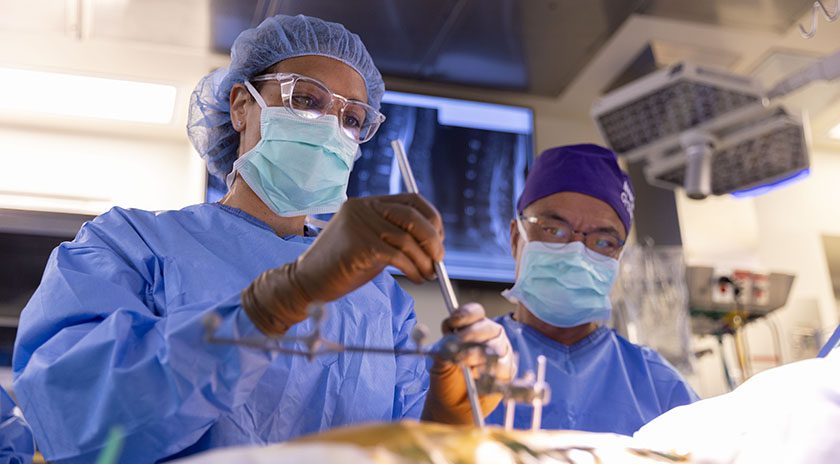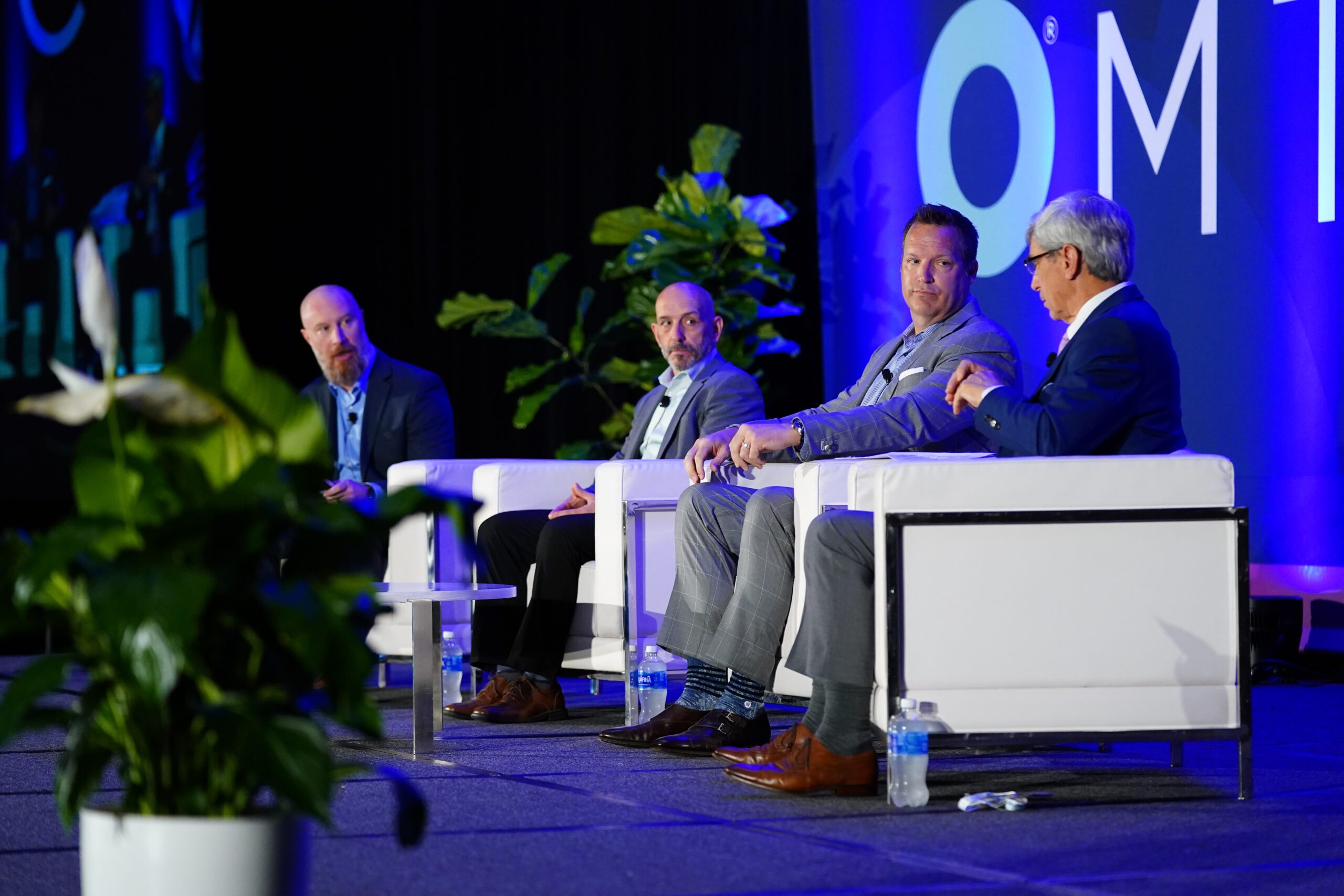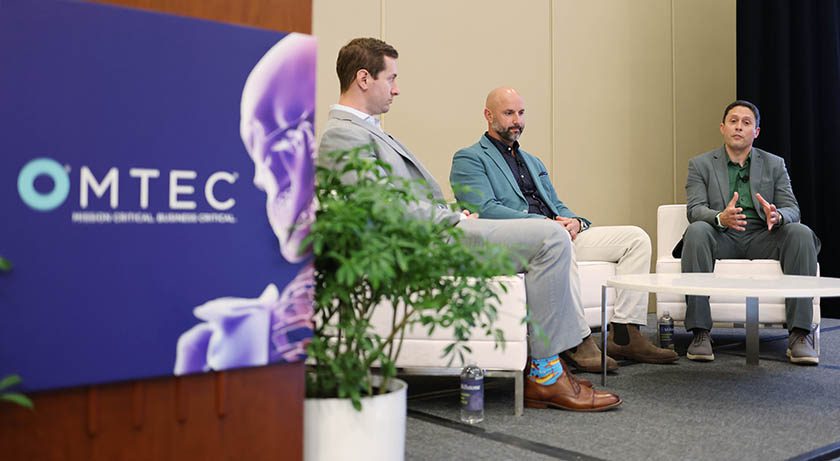

 Copy to clipboard
Copy to clipboard 
Charla Fischer, M.D., was attracted to the spine specialty by the variety of conditions and treatments and the education needed to teach patients about their disorders.
“Spine surgery can be big or small, depending on the procedure, and it requires caring for patients within a large age range,” Dr. Fischer said. “I have patients in their twenties with disc herniation, older patients with stenosis and everything in between. Spine conditions can also be confusing to patients. Patients come in with pain expecting that they’ll need surgery immediately when they might have an injury that will heal naturally. I enjoy teaching my patients.”
Dr. Fischer also loves to learn. She is pushing boundaries in minimally invasive surgery and performed one of the first robotic-assisted spine surgeries in Manhattan. A spine surgeon at NYU Langone, Dr. Fischer also serves as Co-Director of the Endoscopic Spine Surgery Program, Director of Quality and Patient Safety for the Division of Spine Surgery and Chief of Orthopedics for Tisch Hospital and Kimmel Pavilion.
We spoke with Dr. Fischer about her interests in spine techniques and technologies.
One of your colleagues described you as the most minimally invasive surgeon. Why has minimally invasive surgery been an important path for you?
Dr. Fischer: It’s the future of spine surgery. I often joke that in 200 years, humans will be saying, ‘I can’t believe they operated on people and didn’t use a laser, nanorobot or genetics to fix conditions.’
I’m also a conservative surgeon, meaning I believe in trying non-surgical options before performing surgery. When I need to perform surgery, I take a focused approach to making small incisions or tiny incisions with endoscopic techniques. Other orthopedic specialties have moved in this direction. Surgeons use scopes on shoulders, ankles, elbows and knees. It is time to cross over to the spine and make sure it can be done safely and effectively.
Also, patients experience less pain with minimally invasive techniques. The size of the incision is not what matters; it’s the muscle disruption underneath. I performed a two-level endoscopic TLIF on a 74-year-old patient earlier this week, and she left the hospital the next day. There is a significant difference in recovery compared to traditional open surgery.
What changes or improvements could be made to the technology you’re using to help you perform even more minimally invasive or endoscopic procedures? Are there tools you’re missing?
Dr. Fischer: We’re using tools designed for the knee and shoulder. I believe teaching other surgeons about minimally invasive surgery and working with companies to improve how these techniques are performed will make spine surgery faster and easier. What’s really exciting is that we only need to make minor adjustments to tools and techniques — it’s not going to take a revolution. We need to train surgeons and get their feedback so that they can see it is technically possible.
What type of procedures are you doing endoscopically?
Dr. Fischer: Mostly posterior lumbar procedures: TLIF fusions, laminectomies, microdiscectomies. I’ll do a one-level or two-level TLIF and couple it with the robotic pedicle screw placement for a straightforward approach.
Amazingly, we can merge technologies to make tiny incisions for the patient and a more ergonomically friendly procedure for the surgeon. I prefer to look up at a screen as opposed to looking down with the camera and working portal. When I think about performing surgery for 20 more years, my mind goes to my physical well-being. We must teach fellows and residents to think about ergonomics when they’re setting up their space in the O.R. to make sure that they maintain the longevity of their bodies throughout their careers.
You mentioned robotics. You were also one of the first spine surgeons in New York to perform robotic-assisted surgery. What do you think about current technology? What modifications would you like to see in next-generation robots?
Dr. Fischer: Today’s robotic systems are great. The technology is fast, smooth and intuitive. I would like to see the bases get smaller so they fit better in the operating room. I think they will get smaller, easier to use and possibly cheaper so that more hospitals can use them. It would be great to take the technology to the next step of burring for laminotomies or facet prep to make those processes more automated and guided.
I used a robot during my residency at Columbia Presbyterian, and then we looked at different robots when I came to NYU. Because the systems became more user-friendly, it made sense to utilize the technology, and it has become widely used at our institution. Now, we are asking what else robots can do and whether there are other enabling technologies that we need.
Surgeons and industry are excited about enabling technology, but adoption remains low. What are the barriers to increased acceptance among surgeons?
Dr. Fischer: It’s usually having enough case volumes to get through the learning curve. It’s not a long learning curve, but it requires education for yourself and your staff. When starting robotic or endoscopic procedures, it is important to have a nurse champion, someone who can go through extra training and then help in the early cases to make other surgical team members comfortable.
Endoscopic biportal procedures definitely involve more training than robotic cases. However, the learning curve is worth it when you see the patient outcomes after using these techniques.
You’re also the Director of Quality and Patient Safety. What does that work entail?
Dr. Fischer: The goal is to make systems better for surgeons and patients. It involves educating residents and fellows, properly documenting processes and fostering a culture where mistakes can be made. There is no penalty for surgical complications in an environment where we can talk about issues in honest ways that ultimately help patients.
We also organize conversations with partners like anesthesia and neurosurgery about high-risk patients. If a patient meets our high-risk criteria, they must be presented to a multidisciplary team for comprehensive assessment. This helps the surgeon prepare for the surgery and ensures that the surgery is safe for the patient. The team often discusses whether the patient is a candidate for a smaller surgery or a fusion.
What else excites you about spine surgery today?
Dr. Fischer: Biportal endoscopic surgery is very exciting and fun, so I’m really focused on that right now. I believe in endoscopic techniques so much that I just had my partner perform surgery on my mom. It was amazing to watch her recover so quickly.
I also think biologics is the future and the next wave of innovation. Dual expansion cages are exciting; I can’t think of any revisions or non-unions I’ve had from using those implants. The idea of using better implants and orthobiologics so that I do not have to revise a patient excites me.
My research topics focus on social determinants of health and the timing of surgery, so I am always interested in understanding healthcare inequities and how we can improve patients’ lives.
Do you have a supportive platform for your research interests?
Dr. Fischer: NYU accepts a wide range of insurance plans, so coverage isn’t a barrier to patients receiving treatments. I do believe surgeon diversity leads to patient diversity. My division is one of the most diverse in the country. As a leader, I’ll continue to advocate that it’s important to recruit talented, kind surgeons with diverse representations who want to help patients, no matter what type of insurance they have or what they look like.
Charla Fischer, M.D., was attracted to the spine specialty by the variety of conditions and treatments and the education needed to teach patients about their disorders.
“Spine surgery can be big or small, depending on the procedure, and it requires caring for patients within a large age range,” Dr. Fischer said. “I have patients in their...
Charla Fischer, M.D., was attracted to the spine specialty by the variety of conditions and treatments and the education needed to teach patients about their disorders.
“Spine surgery can be big or small, depending on the procedure, and it requires caring for patients within a large age range,” Dr. Fischer said. “I have patients in their twenties with disc herniation, older patients with stenosis and everything in between. Spine conditions can also be confusing to patients. Patients come in with pain expecting that they’ll need surgery immediately when they might have an injury that will heal naturally. I enjoy teaching my patients.”
Dr. Fischer also loves to learn. She is pushing boundaries in minimally invasive surgery and performed one of the first robotic-assisted spine surgeries in Manhattan. A spine surgeon at NYU Langone, Dr. Fischer also serves as Co-Director of the Endoscopic Spine Surgery Program, Director of Quality and Patient Safety for the Division of Spine Surgery and Chief of Orthopedics for Tisch Hospital and Kimmel Pavilion.
We spoke with Dr. Fischer about her interests in spine techniques and technologies.
One of your colleagues described you as the most minimally invasive surgeon. Why has minimally invasive surgery been an important path for you?
Dr. Fischer: It’s the future of spine surgery. I often joke that in 200 years, humans will be saying, ‘I can’t believe they operated on people and didn’t use a laser, nanorobot or genetics to fix conditions.’
I’m also a conservative surgeon, meaning I believe in trying non-surgical options before performing surgery. When I need to perform surgery, I take a focused approach to making small incisions or tiny incisions with endoscopic techniques. Other orthopedic specialties have moved in this direction. Surgeons use scopes on shoulders, ankles, elbows and knees. It is time to cross over to the spine and make sure it can be done safely and effectively.
Also, patients experience less pain with minimally invasive techniques. The size of the incision is not what matters; it’s the muscle disruption underneath. I performed a two-level endoscopic TLIF on a 74-year-old patient earlier this week, and she left the hospital the next day. There is a significant difference in recovery compared to traditional open surgery.
What changes or improvements could be made to the technology you’re using to help you perform even more minimally invasive or endoscopic procedures? Are there tools you’re missing?
Dr. Fischer: We’re using tools designed for the knee and shoulder. I believe teaching other surgeons about minimally invasive surgery and working with companies to improve how these techniques are performed will make spine surgery faster and easier. What’s really exciting is that we only need to make minor adjustments to tools and techniques — it’s not going to take a revolution. We need to train surgeons and get their feedback so that they can see it is technically possible.
What type of procedures are you doing endoscopically?
Dr. Fischer: Mostly posterior lumbar procedures: TLIF fusions, laminectomies, microdiscectomies. I’ll do a one-level or two-level TLIF and couple it with the robotic pedicle screw placement for a straightforward approach.
Amazingly, we can merge technologies to make tiny incisions for the patient and a more ergonomically friendly procedure for the surgeon. I prefer to look up at a screen as opposed to looking down with the camera and working portal. When I think about performing surgery for 20 more years, my mind goes to my physical well-being. We must teach fellows and residents to think about ergonomics when they’re setting up their space in the O.R. to make sure that they maintain the longevity of their bodies throughout their careers.
You mentioned robotics. You were also one of the first spine surgeons in New York to perform robotic-assisted surgery. What do you think about current technology? What modifications would you like to see in next-generation robots?
Dr. Fischer: Today’s robotic systems are great. The technology is fast, smooth and intuitive. I would like to see the bases get smaller so they fit better in the operating room. I think they will get smaller, easier to use and possibly cheaper so that more hospitals can use them. It would be great to take the technology to the next step of burring for laminotomies or facet prep to make those processes more automated and guided.
I used a robot during my residency at Columbia Presbyterian, and then we looked at different robots when I came to NYU. Because the systems became more user-friendly, it made sense to utilize the technology, and it has become widely used at our institution. Now, we are asking what else robots can do and whether there are other enabling technologies that we need.
Surgeons and industry are excited about enabling technology, but adoption remains low. What are the barriers to increased acceptance among surgeons?
Dr. Fischer: It’s usually having enough case volumes to get through the learning curve. It’s not a long learning curve, but it requires education for yourself and your staff. When starting robotic or endoscopic procedures, it is important to have a nurse champion, someone who can go through extra training and then help in the early cases to make other surgical team members comfortable.
Endoscopic biportal procedures definitely involve more training than robotic cases. However, the learning curve is worth it when you see the patient outcomes after using these techniques.
You’re also the Director of Quality and Patient Safety. What does that work entail?
Dr. Fischer: The goal is to make systems better for surgeons and patients. It involves educating residents and fellows, properly documenting processes and fostering a culture where mistakes can be made. There is no penalty for surgical complications in an environment where we can talk about issues in honest ways that ultimately help patients.
We also organize conversations with partners like anesthesia and neurosurgery about high-risk patients. If a patient meets our high-risk criteria, they must be presented to a multidisciplary team for comprehensive assessment. This helps the surgeon prepare for the surgery and ensures that the surgery is safe for the patient. The team often discusses whether the patient is a candidate for a smaller surgery or a fusion.
What else excites you about spine surgery today?
Dr. Fischer: Biportal endoscopic surgery is very exciting and fun, so I’m really focused on that right now. I believe in endoscopic techniques so much that I just had my partner perform surgery on my mom. It was amazing to watch her recover so quickly.
I also think biologics is the future and the next wave of innovation. Dual expansion cages are exciting; I can’t think of any revisions or non-unions I’ve had from using those implants. The idea of using better implants and orthobiologics so that I do not have to revise a patient excites me.
My research topics focus on social determinants of health and the timing of surgery, so I am always interested in understanding healthcare inequities and how we can improve patients’ lives.
Do you have a supportive platform for your research interests?
Dr. Fischer: NYU accepts a wide range of insurance plans, so coverage isn’t a barrier to patients receiving treatments. I do believe surgeon diversity leads to patient diversity. My division is one of the most diverse in the country. As a leader, I’ll continue to advocate that it’s important to recruit talented, kind surgeons with diverse representations who want to help patients, no matter what type of insurance they have or what they look like.

You are out of free articles for this month
Subscribe as a Guest for $0 and unlock a total of 5 articles per month.
You are out of five articles for this month
Subscribe as an Executive Member for access to unlimited articles, THE ORTHOPAEDIC INDUSTRY ANNUAL REPORT and more.
CL
Carolyn LaWell is ORTHOWORLD's Chief Content Officer. She joined ORTHOWORLD in 2012 to oversee its editorial and industry education. She previously served in editor roles at B2B magazines and newspapers.







